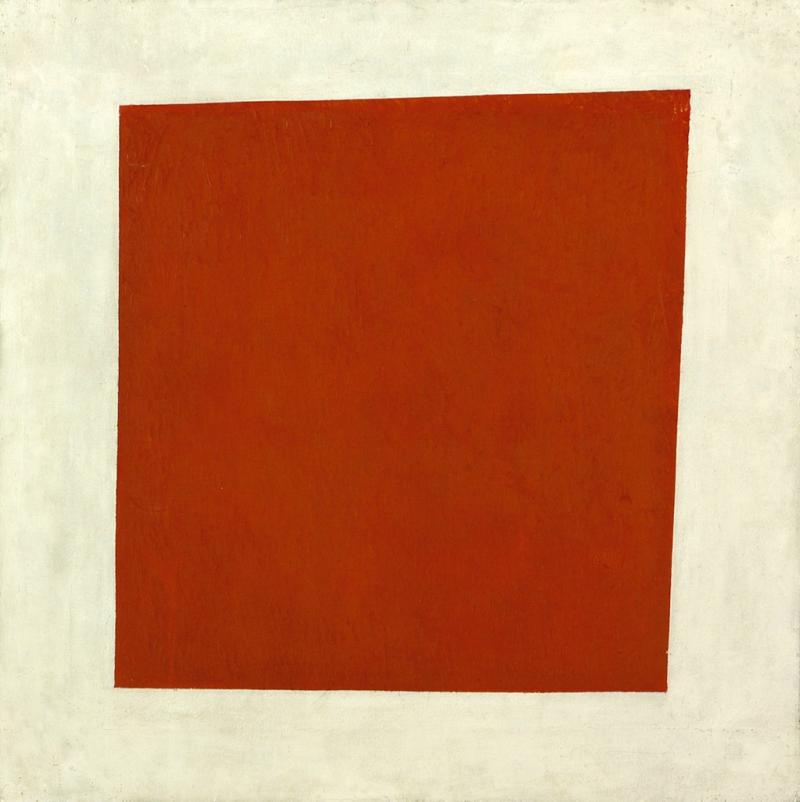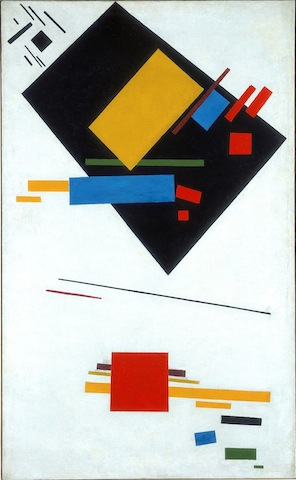Malevich, Tate Modern | reviews, news & interviews
Malevich, Tate Modern
Malevich, Tate Modern
An exhilarating exhibition following the arc of the Russian modernist's career

The year 1915 was a big one for Kazimir Malevich, as it was for the course of modern art. It was the year the Black Square was first exhibited (June 1915 is the likeliest date of the painting’s execution, though Malevich himself dated it to 1913, insisting it derived from his designs for Futurist opera Victory Over the Sun).
Black Square got its first outing in a group show of Russian avant-garde artists, The Last Exhibition of Futurist Painting 0.10, which took place in the newly named Petrograd. Just one photo, which is shown here, exists of that exhibition. We see two walls crammed with Malevich’s Suprematist paintings, a term, like Mondrian’s Neo-Plasticism, to denote an art that pursued “objective reality”, which is probably no more illuminating than the artists’ choice of neologism, but here to quote from source: “The artist can be a creator only when the forms in his picture have nothing in common with nature.” This could be a statement written by either artist, but it was written by Malevich in a booklet entitled From Cubism to Futurism to Suprematism, published in 1915 to outline his theories.
That 1915 exhibition is partially recreated from that small photograph, with nine of the 12 paintings whose whereabouts are known today. The original Black Square is too fragile to travel (in many of the paintings you see the black paint riddled with tiny cracks) and a 1923 version hangs high above the other canvases. It’s in the corner where the two walls meet and where traditionally religious icons were hung in Russian homes. Finding instead a painting of a black void must have given at least a mischievous thrill, if not the full shock of encountering an act of blasphemy.
In the same room we find Red Square (Painterly Realism of a Peasant Woman in Two Dimensions) (main picture). The painting depicts neither a peasant woman nor, strictly speaking, a square, since two sides are slanted. I completely suspect Malevich of having a bit of a joke at the double duplicity (even despite the wonkiness evident in Black Square – his squares are often skewed).
 These small paintings, all from that year, are nearly all painted in single colours against a white ground. Most feature either a single or repeated form – a rectangle, a square, a circle – or intersecting forms, such as a cross. The room exudes a calmness, a stillness, whose spell is broken once you proceed to the next gallery. Here colours are multitudinous and exuberant. Dynamic floating forms – diagonal lines, rectangles, circles, the whole Euclidian army – overlap and intersect. This is what Kandinsky’s paintings begin to look like a whole decade later. (Pictured right: Suprematist Painting (Black Trapezium and Red Square), 1915)
These small paintings, all from that year, are nearly all painted in single colours against a white ground. Most feature either a single or repeated form – a rectangle, a square, a circle – or intersecting forms, such as a cross. The room exudes a calmness, a stillness, whose spell is broken once you proceed to the next gallery. Here colours are multitudinous and exuberant. Dynamic floating forms – diagonal lines, rectangles, circles, the whole Euclidian army – overlap and intersect. This is what Kandinsky’s paintings begin to look like a whole decade later. (Pictured right: Suprematist Painting (Black Trapezium and Red Square), 1915)
Malevich had tried all the French avant-garde isms for size – there’s an earlier room of Cubist paintings, naturally, but with a Russian twist – a samovar is hidden in intersecting Cubist planes, and a gallery of generic, heavy-set peasants traversing the land, with everything glowing in Fauvist colours. Three-quarters of the way in there’s a big room of the charts and graphs he used as teaching aids, and if this is an attempt to blind you with science, it works. Move swiftly on.
Soon we’re under the shadow of Stalin. Malevich’s own revolutionary fervour is countered by the fervour of the terror of the new regime. Its anti-avant-garde ethos prevails. In the early 1930s Malevich is arrested and interrogated and finally released. A final room is devoted to portraits, all painted in 1933: his mother, in a dour 19th-century Realist style; his young daughter painted in an unremarkable Impressionist manner. Then larger Renaissance-style portraits which are also a bit like figures on playing cards. One leaves this final room a little perturbed, or at least I did. He dies in 1935 and his Black Square, along with most of his other paintings, is sequestered by the state, to remain unseen by the public for 50 years.
This is a superb, utterly fascinating exhibition which follows the curious arc of the artist’s whole career. Yet it’s undeniably the Black Square that proves itself as the ultimate statement, the end-point, of Malevich’s artistic endeavours. He used a black square to sign those strange "Renaissance" portraits, and he dies, at the age of 56, with that groundbreaking painting hanging above his bed.
Explore topics
Share this article
The future of Arts Journalism
You can stop theartsdesk.com closing!
We urgently need financing to survive. Our fundraising drive has thus far raised £49,000 but we need to reach £100,000 or we will be forced to close. Please contribute here: https://gofund.me/c3f6033d
And if you can forward this information to anyone who might assist, we’d be grateful.

Subscribe to theartsdesk.com
Thank you for continuing to read our work on theartsdesk.com. For unlimited access to every article in its entirety, including our archive of more than 15,000 pieces, we're asking for £5 per month or £40 per year. We feel it's a very good deal, and hope you do too.
To take a subscription now simply click here.
And if you're looking for that extra gift for a friend or family member, why not treat them to a theartsdesk.com gift subscription?
more Visual arts
 'We are bowled over!' Thank you for your messages of love and support
Much-appreciated words of commendation from readers and the cultural community
'We are bowled over!' Thank you for your messages of love and support
Much-appreciated words of commendation from readers and the cultural community
 Folkestone Triennial 2025 - landscape, seascape, art lovers' escape
Locally rooted festival brings home many but not all global concerns
Folkestone Triennial 2025 - landscape, seascape, art lovers' escape
Locally rooted festival brings home many but not all global concerns
 Sir Brian Clarke (1953-2025) - a personal tribute
Remembering an artist with a gift for the transcendent
Sir Brian Clarke (1953-2025) - a personal tribute
Remembering an artist with a gift for the transcendent
 Emily Kam Kngwarray, Tate Modern review - glimpses of another world
Pictures that are an affirmation of belonging
Emily Kam Kngwarray, Tate Modern review - glimpses of another world
Pictures that are an affirmation of belonging
 Kiefer / Van Gogh, Royal Academy review - a pairing of opposites
Small scale intensity meets large scale melodrama
Kiefer / Van Gogh, Royal Academy review - a pairing of opposites
Small scale intensity meets large scale melodrama
 Jenny Saville: The Anatomy of Painting, National Portrait Gallery review - a protégé losing her way
A brilliant painter in search of a worthwhile subject
Jenny Saville: The Anatomy of Painting, National Portrait Gallery review - a protégé losing her way
A brilliant painter in search of a worthwhile subject
 Abstract Erotic, Courtauld Gallery review - sculpture that is sensuous, funny and subversive
Testing the boundaries of good taste, and winning
Abstract Erotic, Courtauld Gallery review - sculpture that is sensuous, funny and subversive
Testing the boundaries of good taste, and winning
 Edward Burra, Tate Britain review - watercolour made mainstream
Social satire with a nasty bite
Edward Burra, Tate Britain review - watercolour made mainstream
Social satire with a nasty bite
 Ithell Colquhoun, Tate Britain review - revelations of a weird and wonderful world
Emanations from the unconscious
Ithell Colquhoun, Tate Britain review - revelations of a weird and wonderful world
Emanations from the unconscious
 Rachel Jones: Gated Canyons, Dulwich Picture Gallery review - teeth with a real bite
Mouths have never looked so good
Rachel Jones: Gated Canyons, Dulwich Picture Gallery review - teeth with a real bite
Mouths have never looked so good
 Yoshitomo Nara, Hayward Gallery review - sickeningly cute kids
How to make millions out of kitsch
Yoshitomo Nara, Hayward Gallery review - sickeningly cute kids
How to make millions out of kitsch
 Hamad Butt: Apprehensions, Whitechapel Gallery review - cool, calm and potentially lethal
The YBA who didn’t have time to become a household name
Hamad Butt: Apprehensions, Whitechapel Gallery review - cool, calm and potentially lethal
The YBA who didn’t have time to become a household name

Add comment